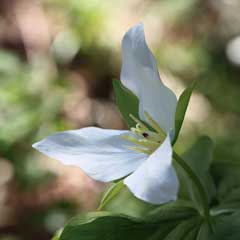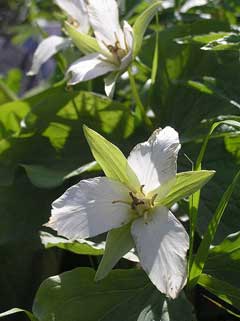 |
|
www.flickr.com/photos/tanaka_juuyoh |
 |
|
Translate this page:
Summary
Physical Characteristics

 Trillium kamtschaticum is a PERENNIAL growing to 0.3 m (1ft).
Trillium kamtschaticum is a PERENNIAL growing to 0.3 m (1ft).
See above for USDA hardiness. It is hardy to UK zone 5. It is in flower from June to July, and the seeds ripen in August. The species is hermaphrodite (has both male and female organs).
Suitable for: light (sandy), medium (loamy) and heavy (clay) soils and prefers well-drained soil. Suitable pH: mildly acid, neutral and basic (mildly alkaline) soils. It can grow in full shade (deep woodland) semi-shade (light woodland) or no shade. It prefers moist soil.
UK Hardiness Map
US Hardiness Map
Synonyms
Plant Habitats
Woodland Garden Dappled Shade; Shady Edge; not Deep Shade;
Edible Uses
Edible Parts: Fruit
Edible Uses:
Fruit[105]. No more details are given.
References More on Edible Uses
Medicinal Uses
Plants For A Future can not take any responsibility for any adverse effects from the use of plants. Always seek advice from a professional before using a plant medicinally.
Miscellany
The root contains steroidal saponins, which have hormonal effects on the body[222, 238]. They are being used in gynaecological and obstetric medicine[238].
References More on Medicinal Uses
The Bookshop: Edible Plant Books
Our Latest books on Perennial Plants For Food Forests and Permaculture Gardens in paperback or digital formats.

Edible Tropical Plants
Food Forest Plants for Hotter Conditions: 250+ Plants For Tropical Food Forests & Permaculture Gardens.
More

Edible Temperate Plants
Plants for Your Food Forest: 500 Plants for Temperate Food Forests & Permaculture Gardens.
More

More Books
PFAF have eight books available in paperback and digital formats. Browse the shop for more information.
Shop Now
Other Uses
References More on Other Uses
Cultivation details
Prefers a deep well-drained woodland or humus-rich soil in a somewhat shady position that remains moist in the summer[1, 42]. Prefers a neutral to slightly acid soil[200]. Grows well in open woodland[1]. Succeeds in deep shade[188]. Succeeds in a sunny position if the soil does not dry out[42]. Any transplanting is best done whilst the plants are in flower[200]. Plants can flower in two years from seed[138]. Members of this genus are rarely if ever troubled by browsing deer or rabbits[233], though slugs are very fond of the leaves[238].
References Carbon Farming Information and Carbon Sequestration Information
Temperature Converter
Type a value in the Celsius field to convert the value to Fahrenheit:
Fahrenheit:
The PFAF Bookshop
Plants For A Future have a number of books available in paperback and digital form. Book titles include Edible Plants, Edible Perennials, Edible Trees,Edible Shrubs, Woodland Gardening, and Temperate Food Forest Plants. Our new book is Food Forest Plants For Hotter Conditions (Tropical and Sub-Tropical).
Shop Now
Plant Propagation
Seed - best sown in a shaded cold frame as soon as it is ripe[134, 200]. Stored seed should be sown in late winter or early spring. Seed usually germinates within 1 - 3 months at 15°c. Another report says that seeds produce a root after the first cold stratification but no shoot is produced until after a second winter[138], whilst yet another report says that the seed can take 3 years to germinate[238]. The seedlings are prone to damp off and must therefore be watered with care and given plenty of fresh air[138]. The young plants need to be overwintered in a cold frame for the first year and can then be planted out in late spring. It is very important that the pots become neither too dry nor too wet[138]. Division with care when the plants die down after flowering[200]. Larger divisions can be planted out direct into their permanent positions. We have found that it is best to pot up smaller divisions and grow them on in light shade in a greenhouse or cold frame until they are growing away well. Plant them out in the following spring.
Other Names
If available other names are mentioned here
Native Range
TEMPERATE ASIA: Russian Federation (Kurile Islands, Kamcatskij kraj, Sakhalin), China (Jilin Sheng), Korea, Japan (Hokkaidô)
Weed Potential
Right plant wrong place. We are currently updating this section.
Please note that a plant may be invasive in one area but may not in your area so it's worth checking.
Conservation Status
IUCN Red List of Threatened Plants Status :

| Related Plants
|
| Latin Name | Common Name | Habit | Height | Hardiness | Growth | Soil | Shade | Moisture | Edible | Medicinal | Other |
| Trillium erectum | Beth Root - Indian Balm, Red trillium, Wakerobin, Purple Trillium | Perennial | 0.4 |
4-9
| S | LMH | FSN | M | 2 | 3 | |
| Trillium grandiflorum | White Trillium, Large Flower Trillium, White Trillium, Large Flower Wakerobin, Large Flowered Tril | Perennial | 0.4 |
4-9
| S | LMH | FSN | M | 1 | 2 | |
| Trillium ovatum | Wakerobin, Pacific trillium, Oettinger's trillium, Hibberson's trillium | Perennial | 0.4 |
4-8
| | LMH | FSN | M | 1 | 1 | |
| Trillium pendulum | | Perennial | 0.3 |
-
| | LMH | FSN | M | 0 | 1 | |
| Trillium sessile | Toadshade | Perennial | 0.4 |
4-8
| | LMH | FSN | M | 2 | 1 | |
| Trillium smallii | | Perennial | 0.4 |
4-8
| | LMH | FSN | M | 1 | 0 | |
| Trillium tschonoskii | | Perennial | 0.2 |
4-8
| | LMH | FSN | M | 1 | 2 | |
| Trillium undulatum | Painted Trillium | Perennial | 0.2 |
4-8
| | LMH | FSN | M | 1 | 1 | |
|
Growth: S = slow M = medium F = fast. Soil: L = light (sandy) M = medium H = heavy (clay). pH: A = acid N = neutral B = basic (alkaline). Shade: F = full shade S = semi-shade N = no shade. Moisture: D = dry M = Moist We = wet Wa = water.
Now available:
Food Forest Plants for Mediterranean Conditions
350+ Perennial Plants For Mediterranean and Drier Food Forests and Permaculture Gardens.
[Paperback and eBook]
This is the third in Plants For A Future's series of plant guides for food forests tailored to
specific climate zones. Following volumes on temperate and tropical ecosystems, this book focuses
on species suited to Mediterranean conditions—regions with hot, dry summers and cool, wet winters,
often facing the added challenge of climate change.
Read More
Expert comment
Author
Pall.
Botanical References
58200266
Links / References
For a list of references used on this page please go here
Readers comment
| Add a comment |
|
If you have important information about this plant that may help other users please add a comment or link below. Only comments or links that are felt to be directly relevant to a plant will be included. If you think a comment/link or information contained on this page is inaccurate or misleading we would welcome your feedback at [email protected]. If you have questions about a plant please use the Forum on this website as we do not have the resources to answer questions ourselves.
* Please note: the comments by website users are not necessarily those held by PFAF and may give misleading or inaccurate information.
To leave a comment please Register or login here All comments need to be approved so will not appear immediately.
|
Subject : Trillium kamtschaticum
|
|
|
|